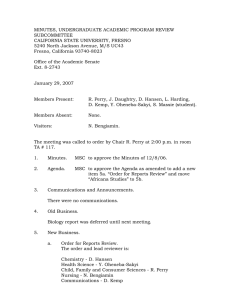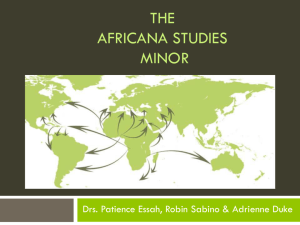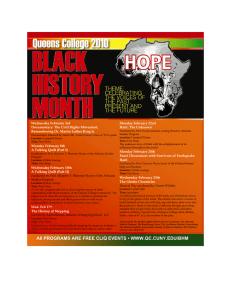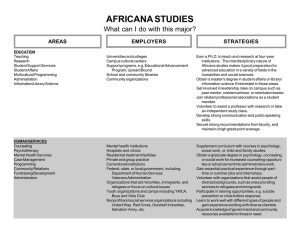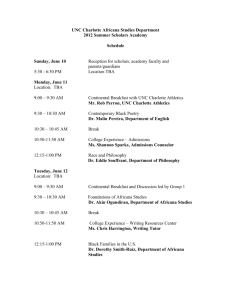Asian Journal of Medical Sciences 5(1): 26-32, 2013
advertisement
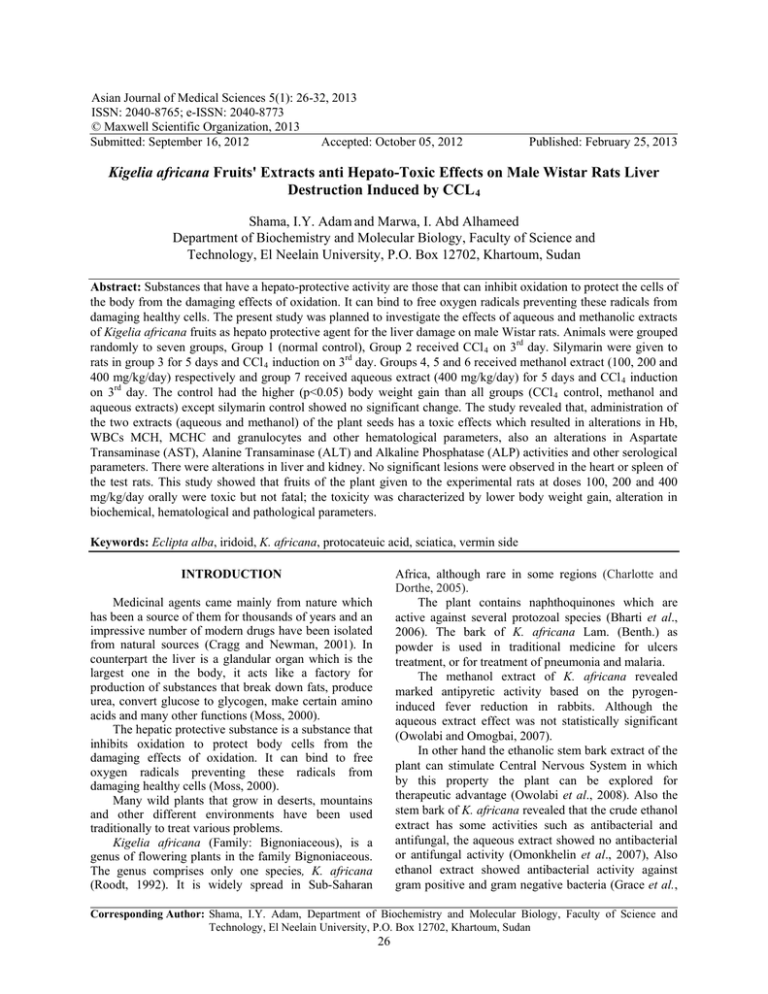
Asian Journal of Medical Sciences 5(1): 26-32, 2013 ISSN: 2040-8765; e-ISSN: 2040-8773 © Maxwell Scientific Organization, 2013 Submitted: September 16, 2012 Accepted: October 05, 2012 Published: February 25, 2013 Kigelia africana Fruits' Extracts anti Hepato-Toxic Effects on Male Wistar Rats Liver Destruction Induced by CCL 4 Shama, I.Y. Adam and Marwa, I. Abd Alhameed Department of Biochemistry and Molecular Biology, Faculty of Science and Technology, El Neelain University, P.O. Box 12702, Khartoum, Sudan Abstract: Substances that have a hepato-protective activity are those that can inhibit oxidation to protect the cells of the body from the damaging effects of oxidation. It can bind to free oxygen radicals preventing these radicals from damaging healthy cells. The present study was planned to investigate the effects of aqueous and methanolic extracts of Kigelia africana fruits as hepato protective agent for the liver damage on male Wistar rats. Animals were grouped randomly to seven groups, Group 1 (normal control), Group 2 received CCl 4 on 3rd day. Silymarin were given to rats in group 3 for 5 days and CCl 4 induction on 3rd day. Groups 4, 5 and 6 received methanol extract (100, 200 and 400 mg/kg/day) respectively and group 7 received aqueous extract (400 mg/kg/day) for 5 days and CCl 4 induction on 3rd day. The control had the higher (p<0.05) body weight gain than all groups (CCl 4 control, methanol and aqueous extracts) except silymarin control showed no significant change. The study revealed that, administration of the two extracts (aqueous and methanol) of the plant seeds has a toxic effects which resulted in alterations in Hb, WBCs MCH, MCHC and granulocytes and other hematological parameters, also an alterations in Aspartate Transaminase (AST), Alanine Transaminase (ALT) and Alkaline Phosphatase (ALP) activities and other serological parameters. There were alterations in liver and kidney. No significant lesions were observed in the heart or spleen of the test rats. This study showed that fruits of the plant given to the experimental rats at doses 100, 200 and 400 mg/kg/day orally were toxic but not fatal; the toxicity was characterized by lower body weight gain, alteration in biochemical, hematological and pathological parameters. Keywords: Eclipta alba, iridoid, K. africana, protocateuic acid, sciatica, vermin side Africa, although rare in some regions (Charlotte and Dorthe, 2005). The plant contains naphthoquinones which are active against several protozoal species (Bharti et al., 2006). The bark of K. africana Lam. (Benth.) as powder is used in traditional medicine for ulcers treatment, or for treatment of pneumonia and malaria. The methanol extract of K. africana revealed marked antipyretic activity based on the pyrogeninduced fever reduction in rabbits. Although the aqueous extract effect was not statistically significant (Owolabi and Omogbai, 2007). In other hand the ethanolic stem bark extract of the plant can stimulate Central Nervous System in which by this property the plant can be explored for therapeutic advantage (Owolabi et al., 2008). Also the stem bark of K. africana revealed that the crude ethanol extract has some activities such as antibacterial and antifungal, the aqueous extract showed no antibacterial or antifungal activity (Omonkhelin et al., 2007), Also ethanol extract showed antibacterial activity against gram positive and gram negative bacteria (Grace et al., INTRODUCTION Medicinal agents came mainly from nature which has been a source of them for thousands of years and an impressive number of modern drugs have been isolated from natural sources (Cragg and Newman, 2001). In counterpart the liver is a glandular organ which is the largest one in the body, it acts like a factory for production of substances that break down fats, produce urea, convert glucose to glycogen, make certain amino acids and many other functions (Moss, 2000). The hepatic protective substance is a substance that inhibits oxidation to protect body cells from the damaging effects of oxidation. It can bind to free oxygen radicals preventing these radicals from damaging healthy cells (Moss, 2000). Many wild plants that grow in deserts, mountains and other different environments have been used traditionally to treat various problems. Kigelia africana (Family: Bignoniaceous), is a genus of flowering plants in the family Bignoniaceous. The genus comprises only one species, K. africana (Roodt, 1992). It is widely spread in Sub-Saharan Corresponding Author: Shama, I.Y. Adam, Department of Biochemistry and Molecular Biology, Faculty of Science and Technology, El Neelain University, P.O. Box 12702, Khartoum, Sudan 26 Asian J. Med. Sci., 5(2): 26-32, 2013 2002), some antioxidant activity (Olaleye and Rocha, 2008) and anti diabetic activity (Nayarko et al., 2005). The major constituents isolated from the polar extract of the fruit of K. africana are verminosides and iridoids and series of polyphenols such as verbascoside. Also In vitro assays showed that verminoside had significant anti-inflammatory effects (Patrizia et al., 2008). The crude stem bark and fruit extracted with dichloromethane showed cytotoxic activity In vitro against cultured melanoma and other cancer cell lines (Jackson et al., 2000). The plant has many medicinal properties because of the presence of many secondary metabolites which include iridoids, flavonoids and napthoquinones and volatile constituents (Houghton, 2002). The major constituent isolated from the plant is the kigelin which isolated from the root, the stem bark led to the isolation of three known iridoids: specioside, vermenoside and minecoside (Gouda et al., 2003). The present study was therefore planned to investigate the effects of aqueous and methanolic extracts of K. africana fruits as an agent that can prevent or heal the damage of hepatocytes or generally liver damage in experimental rats. Mean Corpuscular Volume (MCV), Mean Corpuscular Hemoglobin (MCH) and Mean Corpuscular Hemoglobin Concentration (MCHC) were determined by automated hematology analyzer. Serobiochemical parameters: Serum samples were analyzed using automated serology analyzer for the activities of Aspartate Transaminase (AST), Alanine Transaminase (ALT) and Alkaline Phosphatase (ALP) and for concentrations of total protein, albumin, globulin and bilirubin. Statistical analysis: The significance of differences between means was compared at each time point using Duncan’s multiple range test after ANOVA for oneway classified data (Snedecor and Cochran, 1989). RESULTS Growth changes: Body weight and body weight gain of rats given daily oral doses of K. africana fruits methanolic extracts at 100 mg/kg (Group 4), 200 mg/kg (Group 5) and 400 mg/kg (Group 6) and aqueous extract at 400 mg/kg (Group 7) for 5 days are presented in Table 1. The control (Group 1) had the higher (p<0.05) body weight gain than all groups (CCl 4 control, Group 4, 5 and 6) except silymarin control (Group 3) which had no significant change. MATERIALS AND METHODS The plant: K. africana fruits were collected from Khartoum state, Sudan, in March, 2010. The plant tissues were cleaned, shade-dried and ground. Hematological changes: The values of Hb, MCH, MCHC, WBCs and granulocytes were higher (p<0.05) in groups 2 and 5, granulocytes were higher (p<0.05) in groups 2, 3, 5, 6 and 7 and lymphocytes were higher (p<0.05) in group 4 than control (Group 1). The values of Hb, RBCs and PCV were lower (p<0.05) in groups 4, 6 and 7, lymphocytes were lower (p<0.05) in groups 2, 5, 6 and 7, WBCs were lower (p<0.05) in groups 4 and 7, granulocytes were lower (p<0.05) in group 4 and Experimental design: Forty two, 2 months-old male Wistar rats were housed within the premises of Biochemistry and Molecular Biology Dept. Faculty of Science and Technology, El-Neelain University, Khartoum, with feed and water provided Ad libitum. Rats were randomly grouped to seven, each of 6 rats. The first group received distilled water for 5 days and represented normal control. Group 2 (induction control) received carbon tetra chloride (CCl 4 ) at dose 3 mL/kg, subcutaneously, 1:1 dilution with olive oil on 3rd day. Group 3 received silymarin (50 mg/kg/day) orally for 5 days and CCl 4 induction on 3rd day. Group 4, 5 and 6 received methanol extract (100, 200 and 400 mg/kg/day) orally respectively and group 7 received aqueous extract (400 mg/kg/day) for 5 days and CCl 4 induction on 3rd day. On the 6th day, the rates were sacrificed, Blood samples were collected at slaughter and analyzed, vital tissues were processed for histopathology. Table 1: Body weight and body weight gain in rats orally given Kigelia africana extracts for 5 days Parameters -------------------------------------------Body weight Body weight gain (g) 0 day gain (g) 6 days Treatment groups 1. Control (normal diet) 93.0±1.2 10.2±1.4* 2. CCL 4 control 92.5±3.4 08.2±1.5* 3. Silymarin control 85.8±2.7 09.3±2.7NS 4. (100 mg/kg/day) methanolic extract 98.8±1.3 05.0±1.4* 5. (200 mg/kg/day) methanolic extract 98.8±1.3 06.2±1.5* 6. (400 mg/kg/day) methanolic extract 82.5±1.1 05.3±1.8* 7. (400 mg/kg/day) aqueous extract 85.0±2.2 08.0±1.5* Values are expressed as mean±S.E; NS: Not significant; *: Significant = (p<0.05) Hematological parameters: Hemoglobin (Hb), Packed Cell Volume (PCV), Red Blood Cells (RBCs), White Blood Cells (WBCs) and differential WBCs counts, 27 Asian J. Med. Sci., 5(2): 26-32, 2013 Table 2: Hematological analysis of rats given Kigelia africana methanol and aqueous extract orally for 5 days Groups ---------------------------------------------------------------------------------------------------------------------------------------------------------------------------1. Control 2. Control 3. Control 4. K. africana 5. K. africana 6. K. africana 7. K. africana Parameters (normal diet) (CCl 4 ) (silymarin) (100 mg/kg/day) (200 mg/kg/day) (400 mg/kg/day) (400 mg/kg/day) 6 days NS NS Hb (g/dL) 16.9±0.5 29.8±0.5* 16.9±1.8 12.6±0.5 21.4±0.4* 14.3±0.6* 09.7±0.6* RBCs(X106 mm3) 10.4±0.5 09.6±0.6NS 10.9±1.4NS 08.2±0.6* 10.5±0.3NS 08.2±0.6* 06.0±0.5* PCV (%) 68.3±2.6 60.2±2.2* 69.9±2.6NS 52.7±2.8* 65.4±1.9NS 51.6±2.5* 37.5±2.8* MCV (m3) 65.4±0.7 62.8±0.9 NS 64.2±0.5NS 64.0±0.6NS 62.0±0.7NS 63.0±0.7NS 63.5±0.7NS MCH (pg) 16.2±0.3 32.5±0.4* 15.2±0.6NS 15.5±0.6NS 20.4±0.3* 17.8±0.4NS 16.2±0.7NS NS NS NS MCHC (%) 24.8±0.3 51.7±0.2* 23.8±0.5 24.3±0.4 32.7±0.3* 28.2±0.2 23.4±0.4NS 3 3 NS NS WBCs (X10 mm ) 10.1±1.6 16.8±1.4* 11.4±1.8 07.0±1.8* 25.9±1.5* 10.5±1.5 06.9±1.6NS 40.7±7.6 58.6±7.7* 48.5±7.6* 31.6±7.4* 62.3±7.7* 51.2±7.5* 51.4±7.5* Granulocytes (%) Lymphocytes (%) 53.9±7.2 32.8±6.9* 49.1±7.1NS 61.9±7.3* 28.6±7.0* 44.9±7.1* 41.6±7.3* Values are expressed as mean±S.E; NS: Not significant; *: Significant = (p<0.05) Table 3: Hematological analysis of rats given Kigelia africana methanol and aqueous extract orally for 5 days Groups ------------------------------------------------------------------------------------------------------------------------------------------2. Control 4. K. africana 5. K. africana 6. K. africana 7. K. africana Parameters (CCl 4 ) (100 mg/kg/day) (200 mg/kg/day) (400 mg/kg/day) (400 mg/kg/day) 6 days Hb (g/dL) 29.8±4.2 12.6±4.3* 21.4±4.0* 14.3±4.3* 09.7±4.1* RBCs (X106 mm3) 09.6±0.6 08.2±0.6* 10.5±0.5NS 08.2±0.8* 06.0±0.7* NS PCV (%) 60.2±4.2 52.7±4.3* 65.4±4.1 51.6±4.4* 37.5±4.3* MCV (m3) 62.8±0.9 64.0±0.8NS 62.0±0.7NS 63.0±0.7NS 63.5±0.7NS MCH (pg) 32.5±5.8 15.5±5.6* 20.4±5.8* 17.8±5.6* 16.2±5.7* MCHC (%) 51.7±1.2 24.3±1.3* 32.7±1.3* 28.2±1.2* 23.4±1.0* 3 3 WBCs (X10 mm ) 16.8±1.2 07.0±1.4* 25.9±1.3* 10.5±1.2* 06.9±1.1* NS Granulocytes (%) 58.6±1.9 31.6±1.6* 62.3±1.7 51.2±1.7* 51.4±1.8* Lymphocytes (%) 32.8±3.9 61.9±3.7* 28.6±3.9NS 44.9±3.9* 41.6±3.8* Values are expressed as mean±S.E; NS: Not significant; *: Significant = (p<0.05) Table 4: Hematological analysis of rats given Kigelia africana methanol and aqueous extracts orally for 5 days Groups ------------------------------------------------------------------------------------------------------------------------------------------3. Control 4. K. africana 5. K. africana 6. K. africana 7. K. africana Parameters (silymarin) (100 mg/kg/day) (200 mg/kg/day) (400 mg/kg/day) (400 mg/kg/day) 6 days Hb (g/dL) 16.9±1.8 12.6±1.8* 21.4±1.9* 14.3±1.6* 09.7±1.6* RBCs (X106 mm3) 10.9±1.4 08.2±1.3* 10.5±1.3NS 08.2±1.4* 06.0±1.6* NS PCV (%) 69.9±0.6 52.7±0.7* 65.4±0.5 51.6±0.6* 37.5±0.7* 3 NS NS NS MCV (m ) 64.2±0.3 64.0±0.4 62.0±0.5 63.0±0.5 63.5±0.3NS NS MCH (pg) 15.2±0.6 15.5±0.6 20.4±0.8* 17.8±0.6* 16.2±0.7NS MCHC (%) 23.8±1.0 24.3±0.9NS 32.7±1.3* 28.2±1.2* 23.4±1.0NS WBCs (X103 mm3) 11.4±1.8 07.0±1.8* 25.9±1.5* 10.5±1.5NS 06.9±1.9* Granulocytes (%) 48.5±0.6 31.6±0.5* 62.3±0.7* 51.2±0.5NS 51.4±0.5NS Lymphocytes (%) 49.1±1.6 61.9±1.5* 28.6±2.0* 44.9±1.2* 41.6±1.1* Values are expressed as mean±S.E; NS: Not significant; *: Significant = (p<0.05) P P P P P P P P P P P P P P P P P P P P P P P P P P P P P PCV was lower (p<0.05) in group 2 than normal control (Group 1). These data are represented in Table 2. In Table 3, the values of Hb, MCH and MCHC, were lower (p<0.05) in groups 4, 5, 6 and 7. RBCs, granulocytes, PCV and WBCs were lower (p<0.05) in groups 4, 6 and 7, lymphocytes were higher (p<0.05) in groups 4, 6 and 7 and WBCs were higher (p<0.05) in group 5 than CCL 4 control. For Table 4, the values of Hb, MCH, MCHC, WBCs and granulocytes were higher (p<0.05) in group 5, MCH and MCHC were higher (p<0.05) in group 6 and lymphocytes were higher (p<0.05) in group 4 than silymarin control (Group 3). The values of Hb, RBCs and PCV were lower (p<0.05) in groups 4, 6 and 7, value of WBCs was lower (p<0.05) in groups 4 and 7, R P P granulocytes were lower (p<0.05) in group 4 and lymphocytes were lower (p<0.05) in groups 5, 6 and 7, than silymarin control (Group 3). Serobiochemical changes: Serobiochemical changes for rats given methanolic and aqueous extracts for 5 days are presented in Table 5. The activity of AST and ALP was higher (p<0.05) in groups 4, 5, 6 and 7, AST and ALT were higher (p<0.05) in group 3, AST and ALP was higher (p<0.05) in group 2, concentrations of globulin and bilirubin were higher (p<0.05) in group 4 and the activity of ALT was higher (p<0.05) in groups 4, 5 and 7, than control (Group 1). The concentrations of total protein, albumin‚ globulin‚ and bilirubin were lower (p<0.05) in group 7, concentrations of total protein, globulin and albumin and activity of ALT were R 28 Asian J. Med. Sci., 5(2): 26-32, 2013 Table 5: Serobiochemical analysis of rats given Kigelia africana methanol and aqueous extracts orally for 5 days Groups ---------------------------------------------------------------------------------------------------------------------------------------------------1. Control 2. Control 3. Silymarin 4. K. africana 5. K. africana 6. K. africana 7. K. africana Parameters (normal diet) (CCl 4 ) control (100 mg/kg/day) (200 mg/kg/day) (400 mg/kg/day) (400 mg/kg/day) 6 days AST (iu) 09.9±0.7 25.6±0.6* 20.3±0.7* 28.3±0.7* 29.9±0.8* 24.2±0.6* 29.5±0.6* ALT (iu) 10.3±0.9 11.7±0.8NS 20.7±0.8* 17.8±0.7* 20.5±0.9* 05.8±0.8* 24.9±0.7* ALP (iu) 40.7±3.2 93.4±3.8* 30.9±3.3* 63.1±3.4* 67.0±3.3* 83.0±3.2* 69.5±3.1* NS NS NS NS Total protein (g/L) 07.7±0.3 06.8±0.3 08.2±0.4 08.4±0.4 06.9±0.5 05.2±0.3* 04.9±0.2* Albumin (g/L) 04.8±0.5 04 .4±0.5NS 04.4±0.9NS 03.9±0.4* 04.6±0.7NS 03.0±0.5* 02.6±0.4* Globulin (g/L) 02.8±0.5 02.4±0.6NS 03.7±0.4NS 04.4±0.5* 02.3±0.7NS 02.1±0.4* 01.0±0.6* NS NS NS 02.6±0.7 01.3±0.7 03.3±0.5* 00.2±0.6* 02.5±0.9 00.7±0.7* Bilirubin (mg/dL) 02.0±0.7 Values are expressed as mean±S.E; NS: Not significant; *: Significant = (p<0.05) R R P P P P P P P P P P P P P P Table 6: Serobiochemical analysis of rats given Kigelia africana methanol and aqueous extracts orally for 5 days Groups ------------------------------------------------------------------------------------------------------------------------------------------2. Control 4. K. africana 5. K. africana 6. K. africana 7. K. africana Parameters (CCl 4 ) (100 mg/kg/day) (200 mg/kg/day) (400 mg/kg/day) (400 mg/kg/day) 6 days AST (iu) 25.6±0.6 28.3±0.7NS 29.9±0.8NS 24.2±0.6NS 29.5±0.6NS ALT (iu) 11.7±0.8 17.8±0.7* 20.5±0.9* 05.8±0.8* 24.9±0.7* ALP (iu) 93.4±3.8 63.1±3.4* 67.0±3.3* 83.0±3.2* 69.5±3.1* Total protein (g/L) 06.8±0.3 08.4±0.4* 06.9±0.5NS 05.2±0.3* 04.9±0.2* Albumin (g/L) 04 .4±0.5 03.9±0.4NS 04.6±0.7NS 03.0±0.5* 02.6±0.4* Globulin (g/L) 02.4±0.6 04.4±0.5* 02.3±0.7NS 02.1±0.4NS 01.0±0.6* Bilirubin (mg/dL) 02.6±0.7 03.3±0.5NS 00.2±0.6* 02.5±0.9NS 00.7±0.7* Values are expressed as mean±S.E; NS: Not significant; *: Significant = (p<0.05) R R P P P P P P P P P P P P P P P P Table 7: Serobiochemical analysis of rats given Kigelia africana methanol and aqueous extracts orally for 5 days Groups ------------------------------------------------------------------------------------------------------------------------------------------3. Silymarin 4. K. africana 5. K. africana 6. K. africana 7. K. africana Parameters control (100 mg/kg/day) (200 mg/kg/day) (400 mg/kg/day) (400 mg/kg/day) 6 days NS AST (iu) 20.3±0.7 28.3±0.7* 29.9±0.8* 24.2±0.6 29.5±0.6* ALT (iu) 20.7±0.8 17.8±0.7NS 20.5±0.9NS 05.8±0.8* 24.9±0.7NS ALP (iu) 30.9±3.3 63.1±3.4* 67.0±3.3* 83.0±3.2* 69.5±3.1* Total protein 08.2±0.4 08.4±0.4NS 06.9±0.5NS 05.2±0.3* 04.9±0.2* Albumin (g/L) 04.4±0.9 03.9±0.4NS 04.6±0.7NS 03.0±0.5NS 02.6±0.4* Globulin (g/L) 03.7±0.4 04.4±0.5NS 02.3±0.7* 02.1±0.4* 01.0±0.6* Bilirubin (mg/dL) 01.3±0.7 03.3±0.5* 00.2±0.6* 02.5±0.9* 00.7±0.7* Values are expressed as mean±S.E; NS: Not significant; *: Significant = (p<0.05) P P P P P P P P P P P P P P P In Table 7, the activity of AST and ALP were higher (p<0.05) in groups 4, 5 and 7, ALP activity also higher (p<0.05) in group 6 and bilirubin was higher (p<0.05) in groups 4 and 6, than control (Group 3). Concentrations of total protein, albumin, globulin and bilirubin were lower (p<0.05) in group 7, concentrations of globulin and bilirubin were lower (p<0.05) in group 5 and concentration of total protein, albumin and globulin and activity of ALT were lower (p<0.05) in group 6, than silymarin control (Group 3). lower (p<0.05) in group 6, activity of ALP was lower (p<0.05) in group 3, The concentrations of bilirubin was lower (p<0.05) in group 5 and concentration of albumin was lower (p<0.05) in group 4, than normal control (Group 1). In Table 6, the activity of ALT was higher (p<0.05) in groups 4, 5 and 7 and concentration of total protein and globulin was higher (p<0.05) in group 4 than CCL 4 control (Group 2). The activity of ALP and concentrations of total protein, albumin‚ globulin and bilirubin were lower (p<0.05) in group 7, concentrations of total protein and albumin and activity of ALT and ALP were lower (p<0.05) in group 6, bilirubin and activity of ALP were lower (p<0.05) in group 5 and ALP activity was lower (p<0.05) in group 4 than CCL 4 control (Group 2). R R R Pathological changes: In group 3, lesions were consistent and included cytoplasmic fatty vaculation and necrosis of the centrilobular hepatocytes (Fig. 1). Cytoplasmic fatty vaculation, hemorrhage and necrosis of the centrilobular hepatocytes (Fig. 2). And R 29 Asian J. Med. Sci., 5(2): 26-32, 2013 most commonly used by traditional healers to treat wide range of skin ailments like, fungal infections, boils, psoriasis and eczema. It also has internal application including the treatment in dysentery, ring worm, tapeworm, post-partum hemorrhage, malaria, pneumonia and toothache (Gill, 1992). Study conducted by Ufodike and Omoregie (2008) evaluating the acute toxicity of water extracts of the barks of plants, Balanites aegyptiaca and Kigelia africana, to the Nile tilapia, was investigated using static bioassays and continuous aeration. Extract of B. aegyptiaca was observed to be more toxic than that of K. africana; this study represents evidence to the slight toxicity that rose in the result of our study. In other hand, as the plant of our study was used here as hepatoprotective agent in which showed negative result for this property but a research conducted by Dhanabal et al. (2006) showed that Chloroform extract of leaves of Polygala arvensis used for hepatoprotective activity in Wistar albino rats by inducing hepatic injury with D-galactosamine, showed the chloroform extract of the above mentioned plant at an oral dose of 200 and 400 mg/kg exhibited a significant protection effect. Silybum marianum (Asteraceae) was being used as a general medicinal herb and is one of the oldest and thoroughly researched plants in the treatment of liver diseases (Pradhan and Girish, 2006). The alcoholic extract of fresh leaves of the plant Eclipta alba exhibited maximum hepatoprotective activity and is the active fraction for hepatoprotective activity of Eclipta alba leave (Sniqh et al., 2001). This study although indicated the hepato protective effect of the plant Silybum marianum and the plant K. africana prescribed locally for treatment of some liver diseases, K. africana doesn’t show any activity against liver damage. Both the alcoholic and aqueous extracts of the leaves of Nyctanthes arbor-tristis Linn. Showed significant hepatoprotective activity by reducing the elevated levels of biochemical parameters at a dose of 500 mg/kg body weight, this was stated by Hukkeri et al. (2006) and a research conducted by Jayasekhar et al. (1997) indicated that the ethyl acetate extract of Acacia catechu, katha exhibited significant hepatoprotective activity in albino Rats induced acute liver damage. Here in our study, the results obtained are against those 2 mentioned studies above in which the biochemical and pathological parameters are altered in away supporting the toxic effect of this plant rather than the hepatoprotective activity. The results of the present study indicated that the K. africana fruits are toxic to wistar rats when given at 100, 200, 400 mg/kg/day orally, The characteristic features of the K. africana extracts is the change in Fig. 1: Liver of rat receiving daily oral doses of aqueous extract 400 mg/kg of K. africana for 5 days showing cytoplasmic fatty vaculation and necrosis of the centrilobular hepatocytes H & E (X100) Fig. 2: Liver of rat receiving daily oral doses of methanol extract 400 mg/kg of K. africana for 5 days showing cytoplasmic fatty vaculation, hemorrhage and necrosis of the centrilobular hepatocytes H & E (X200) Fig. 3: Kidney of rat receiving daily oral doses of methanol extract 400 mg/kg of K. africana for 5 days showing glomeular alteration, dilatation, necrosis, fatty change and packing of the glomeular tubules H & E (X200) glomeular alteration, dilatation and packing of the glomeular tubules (Fig. 3). No significant lesions were observed in the heart or spleen of the test rats. DISCUSSION The plant K. africana have medicinal properties in which make it used in treatment of many diseases and 30 Asian J. Med. Sci., 5(2): 26-32, 2013 growth rates and the cytoplasmic fatty vaculation and necrosis of the centrilobular hepatocytes in the liver attributed to the increases in the activity of AST and the lower concentration of albumin and decreased activity of ALT resulting from inability of the hepatocytes to synthesize the enzyme and albumin in insufficiency or over excretion in urine in renal dysfunction, Also the concentration of the bilirubin was lower. Study of K. africana suggest that the use of the plant in the treatment of various diseases, as skin ailments, it also has internal application including the treatment in dysentery, post-partum hemorrhage, malaria, pneumonia and diabetes (Gill, 1992). Olaleye and Rocha (2008) evaluate the possible protective effects of administration (100 mg/kg) of K. africana plant especially liver disease and this is probably due to its ability to act as antioxidant. Acute toxicity studies were performed and produced no mortality in dose up to 200 mg/kg orally. The results gave a scientific basis to the traditional uses of K. pinnata particularly involved in inflammation (Carey et al., 2008). The fruits of K. africana given to Wistar rats at dose 100, 200, 400 mg/kg/day orally were toxic but not fatal according to what has been obtained from the result, the toxicity was characterized by lower body weight gain, alteration in biochemical, hematological and pathological parameters. As the plant is prescribed locally for treatment of some diseases and according to what has been gained from this study as slight toxicity to the animal, the plant may produce side effects which could be threatening to those who take it, so further studies would be of value. Gill, L.S., 1992. Ethnomedical Uses of Plants in Nigeria, Union Press, Benin City, pp: 276, ISBN: 9782027200. Gouda, Y.G., A.M. Abdel-Baky, F.M. Darwish, K.M. Mohamed, R. Kasai and K. Yamasaki, 2003. Iridoids from Kigelia pinnata DC, fruits. Phytochemistry, 63: 887-892. Grace, O.M., M.F. Light, K.I. Lindsey, D.A. Mulholland, J. Van Staden and A.K. Fager, 2002. Antibacterial activity and isolation of active compounds from fruit of the traditional African medicinal tree Kigelia africana. South Africa J. Bot., 68: 220-222. Houghton, P.J., 2002. The sausage tree (Kigelia pinnata): Ethnobotany and recent sceintific work. South Africa J. Bot., 68: 14-20. Hukkeri, V.I., A.S. Kusum, R.R. Sureban, B. Gopalakrishna, V.V. Byahatti and S.V. Rajendra, 2006. Hepatoprotective activity of the leaves of Nyctanthes arbor-tristis linn. Indian J. Pharmaceut. Sci., 68: 542-543. Jackson, S.J., P.J. Houghton, S. Retsas and A. Photiou, 2000. In vitro cytotoxicity of norviburtinal and isopinnatal from Kigelia pinnata against cancer cell lines. Planta Med., 66: 785-761. Jayasekhar, P., P.V. Mohan and K. Rathinam, 1997. Hepatoprotective activity of ethyl acetate extract of Acacia catechu. Indian J. Pharmacol., 29: 426-428. Moss, R.W., 2000. Antioxidants against Cancer. Equinox Press Inc., Brooklyn, NY. Nayarko, A.K., L.K.N. Okine, R.K. Wedzi, P.A. Addo and M. Ofsuhene, 2005. Subchronic toxicity studies of the antidiabetic herbal preparation ADD199 in the rat: Absence of organ toxicity and modulation of cytochrome. J. Ethnopharmacol., 97: 319-325. Olaleye, M.T. and B.T. Rocha, 2008. Acetaminopheninduced liver damage in mice: Effects of some medicinal plants on the oxidative defense system. Exp. Toxicol. Pathol., 17: 319-327. Omonkhelin, J.O., K. Eric, I. Omogbai and O. Osahon, 2007. Studies on the anti diarrheal properties of the ethanolic extract of Kigelia africana (Bignoniaceae) stem bark. Afr. J. Biotechnol., 6: 1677-1680. Owolabi, O.J. and E.K.I. Omogbai, 2007. Verification of the folkloric antipyretic claim of the aqueous and ethanolic extracts of Kigelia africana Lam. (Benth.). J. Pharm. Bio Res., 4: 20-24. Owolabi, O.J., F.C. Amaechina and A.B. Eledan, 2008. Central nervous system stimulant effect of the ethanolic extract of Kigelia africana. J. Med. Plants Res., 2: 020-023. REFERENCES Bharti, N., S. Singh, N. Fehmida and A. Amir, 2006. Isolation and in vitro antiamoebi activity of iridoids isolated from Kigelia pinnata. Arkivoc, 2006(10): 69-76. Carey, W.M., M.B.D. Jeevan, R.N. Venkat and M.G. Krishna, 2008. Anti inflammatory activity of the fruit of Kigelia pinnata DC. Pharmacologyonline, 2: 234-245. Charlotte, R. and J. Dorthe, 2005. Sead Leaflet: Kigelia africana (Lam.) Benth. Phytotrade Africa, No. 108. Cragg, G.M. and D.J. Newman, 2001. Medicinals for the millennia: The historical records. Ann. NY Acad. Sci., 953: 3-25. Dhanabal, S.P., G. Syamala, M.N. Satish Kumar and B. Suresh, 2006. Hepatoprotective activity of the indian medicinal plant Polygala arvensis on Dgalactosamine-induced hepatic injury in rats. Fitoterapia, 77(6): 472-474. 31 Asian J. Med. Sci., 5(2): 26-32, 2013 Patrizia, P., A. Giuseppina, M. Stefania, M. Marisa, S. Rokia and P.A. Rita, 2008. Anti-inflammatory Activity of Verminoside from Kigelia africana and evaluation of cutaneous irritation in cell cultures and reconstituted human epidermis. Am. Chem. Soc. Am. Soc. Pharmacog., 68: 1610-1614. Pradhan, S.C. and C. Girish, 2006. Hepatoprotective herbal drug: Silymarin from experimental pharmacology to clinical medicine. Indian J. Med. Res., 124(5): 491-504. Roodt, V., 1992. Kigelia africana in the Shell Field Guide to the Common Trees of the Okavango Delta and Moremi Game Reserve. Shell Oil Botswana, Gaborone, Botswana, pp: 176-180. Snedecor, G.W. and W.C. Cochran, 1989. Statistical Methods. 8th Edn., Iowa State University Press, Ames, Iowa Sniqh, B., A.K. Saxena, B.K. Khandan, S.G. Aqarwal and K.K. Anand, 2001. In vivo hepatoprotective activity of active fraction from ethanolic extract of Eclipta alba leaves. Indian J. Physiol. Pharmacol., 45: 435-441. Ufodike, E.B.C. and E. Omoregie, 2008. Acute toxicity of water extracts of barks of Balanites aegyptiaca and Kigelia africana to Oreochromis niloticus (L.). J. Compil. Blackwell Publ. Ltd., 25: 873-879. 32
